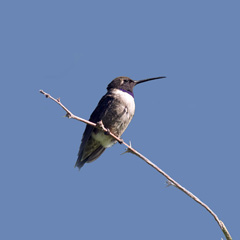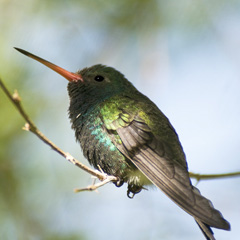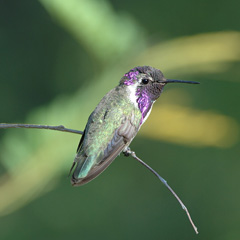|
<<
Back to The Sand Paper Index Page
|
 |
Hummingbirds in Trouble: Part 1
By
James W. Cornett
This article was originally published in The Sand Paper, the membership
newsletter of the
Anza-Borrego Desert Natural History Association |
|
|
|
 |
Imagine going to your neighborhood grocery store and
discovering no food. Even worse, imagine every grocery store within a
day’s drive was without food. What would you do?
For migrating
hummingbirds, the grocery store is the ocotillo and the food is the nectar
held within the blossoms. As the tiny birds arrive each spring, they are
finding more and more ocotillos are not open for business.
The problem isn’t that ocotillos are not blooming. They are. It’s that
some are blooming too soon, before the arrival of migrating hummingbirds.
A warmer environment is the explanation, a phenomenon associated with
changing climatic conditions first brought to the public’s attention in
the early 1980s.
|
|
Black-chinned Hummingbird |
|
|
|
|
Hummingbirds matter.
They are metabolic wonders that have
already taught us much about animal and human physiology. Their renowned
nightly torpor makes them unusual in the avian world. More importantly,
their incredibly rapid wing beats and status as the smallest birds on our
planet require that they maintain unusually high metabolic rates, higher
than any other group of vertebrates. Changes in the gas content of the
atmosphere and patterns of plant growth that humans might not initially
detect are likely to impact hummingbirds first. Their fate, in effect,
acts as an early warning system for significant changes in the
environment.
I first became aware of ocotillos and their special
relationship with hummingbirds early in 2007. In that year, I initiated a
long-term study on ocotillo ecology, in part, because there were dozens of
ocotillos blooming in January, months before migrating hummingbirds would
arrive in the Anza-Borrego region. When I returned home, I scanned the
literature to see if January blooming was expected, or if it was something
new. Not one of the books I checked indicated ocotillos regularly or even
occasionally bloomed in January. California’s premier desert naturalist,
the late Edmund Jaeger, wrote in 1969 in his Desert Wild Flowers that
ocotillos bloomed in April and May, not in the dead of winter. The late
botanist Phillip Munz, in his Flora of Southern California published in
1974, wrote that ocotillos bloom from March to July. As late as 2012, The
Jepson Manual, the most authoritative publication on California plant
life, repeated that ocotillos bloomed from March to July. |
| |
Were all these botanists wrong?
Ever
since the pioneering work of ecologist John Grainger in the first half of
the twentieth century, it has become well known that temperature can be an
important factor determining when plants bloom. Grainger found that
numerous plant species in Britain flowered early each year when
temperatures were higher than normal. Then in 1986, early blooming was
specifically associated with global warming and long-term climate change.
Researchers Melvin Cannell and Rognvald Smith, of the Institute of
Terrestrial Ecology in Scotland, demonstrated how several tree species
were blooming up to 24 days earlier than they had in previous decades.
|
 |
| |
Broad-billed Hummingbird |
| |
|
 |
|
 |
In 2007, Janice Bowers of the U.S. Geological
Survey, brought the issue home to the Sonoran Desert. She was the first
scientist to provide evidence Sonoran Desert shrubs, including ocotillo,
began blooming nearly 40 days earlier than they did a century ago. What’s
more, her study suggested ocotillos and other shrubs ended their bloom
more than a month earlier than in previous decades. This could be bad news
for hummingbirds. In years of drought, the only reliable nectar-producing
plant is the ocotillo and, thus, late-arriving hummingbirds would not find
the energy source they need to complete their migratory journey. A
late-season blooming collapse could also be far reaching. The range of the
ocotillo covers a band from West Texas to California, and so there would
be disastrous consequences for most hummingbird species since all but one
migrates through the Southwest and northern Mexico.
|
|
Costa's Hummingbird |
|
|
|
|
Already, the
numbers of our most beautiful migrant, the Rufous Hummingbird, are in
decline. We don’t know specifically how shifts in ocotillo blooming may be
affecting its decline. What we do know is that Rufous Hummingbirds are
frequently observed sipping nectar from ocotillo blossoms and, as
mentioned above, the range of the ocotillo stretches across the entire
width of the Rufous’ north-south migratory route. And, once again, don’t
forget that the ocotillo is the only plant species that produces nectar in
all years, even in years of severe drought.
To get a handle on the
effects of global warming on Rufous and other hummingbirds, we need hard
data on the blooming patterns of the ocotillo and the timing of migration
of all species of hummingbirds. This is crucial to the fate of
hummingbirds, the plants they pollinate, and our understanding of
environmental change. This is where desert residents and visitors can play
an invaluable role. By collecting annual information on when ocotillos
first bloom and the first and last date of migrating hummingbirds, an
accurate and comprehensive understanding of one facet of environmental
change can be obtained. This, in combination with other monitoring
programs, will help us better understand changes in our environment and
the actions we can take to maintain healthy hummingbird populations and,
more importantly, healthy ecosystems as well.
|
Text and photos by James W. Cornett
|
Biologist James W. Cornett, author or more than 40 books,
is one of the Southwest’s best-known naturalists. Popular publications
include “Wildflowers of Anza-Borrego Desert” and “The
Splendid Ocotillo,” available online at
www.abdnha.org or at ABDNHA’s Borrego
Desert Nature Center. An expert desert ecologist, Cornett has visited and
studied all nine of the world’s great deserts, and owns a consulting
business, JWC Ecological Consultants, specializing in endangered species of
the desert Southwest.
© Anza-Borrego
Desert Natural History Association (ABDNHA), The Sand Paper, Early Spring
2019.
|
|
|
|

|
|